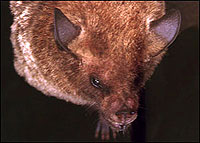The secret life of bats
By Phil Richardson
Breeding and feeding
In temperate areas, bats mate during the autumn or winter. Females seek out males, some of which are known to give out special calls to attract females to mate with them. Some species also probably emit scents, too, for the same purpose: these may be associated with special tufts of hair on the face, shoulders or other parts of the body.
Mating calls

Male Seba's short-tailed fruit bats, Carollia perspicillata, warble greetings to females in their harems. (Image: Phil Richardson)
Male bats give out special calls to let the females know where they are, and possibly to warn off other males. Some do this from a prominent roosting place in a tree or on the side of a building. Others fly up and down the same route, calling as they fly. The calls of microbats are often low-pitched, almost down to the range of human hearing. This means that the sound will travel further, so advertising the bat to a wider audience. Any female passing may be attracted and pay the male a visit.
The noisiest known bats are the males of the hammer-headed fruit bat, Hypsignathus monstrosus, of Africa. They produce a series of loud, low-frequency honking calls at breeding time, not solitarily but in groups (known as leks) with other males. All the males are concentrated in a small area, trying to out-shout each other: the combined cacophony has been aptly compared to a pondful of noisy frogs. If a female ventures near, the calls become more frantic as each suitor tries to lure her with his own sweet love song. In no other mammal has the anatomy been so modified for sound production - the males have large inflatable air-sacs housed in an elongated hammer-shaped head and a huge larynx (voice-box), almost half the length of their backbone, which fills so much of the chest cavity that the heart and lungs are pushed to the back and sides.
Mating
A single male may mate with 30 or more females. Sometimes the element of choice is removed from the mating strategy because males may move around in hibernacula and mate with hibernating females. The females carry the males' live sperm inside the uterus throughout the winter months, ovulate in spring and become pregnant. This method is unusual, and few mammals other than bats use it. Some species of bats rely on delayed implantation, where the egg is produced and fertilised by the sperm, but it is not implanted onto the uterus until a suitable time, often so that birth can coincide with an abundance of suitable food for the nursing mother.
The development rate of a foetus is affected by temperature, so if the mother bat stays active and chooses warm roosts the foetus will develop quickly. Development can be slowed or delayed for weeks by cold conditions. In some species, mating takes place and the egg is fertilised and implanted immediately, but development may be arrested during cold winter months. Others just get straight on with it: fertilisation comes immediately after mating, followed by the development of the embryo and birth. This approach is more common in bats living in tropical areas that are not affected as much by cold weather.
Birth and development of young
Birth occurs usually between 40 days and 6 months after the egg begins to develop (usually the bigger the bat, the slower the gestation period), quite a long time for such small mammals. In temperate areas many species segregate to form maternity colonies, sometimes of many hundreds of expectant females, with males roosting elsewhere, often singly. Some male microbats in tropical areas stand guard over a harem of between 10 and 100 females that roost close to him, chasing other males away if necessary.
A single baby a year is the norm for the majority of species. Some species occasionally have twins and some have twins each time. Four is the greatest number of offspring, although this is unusual and restricted to a very few species, such as the red bat, Lasiurus borealis, of Canada and North America. In tropical areas, some bats manage to produce young twice a year, during the wet seasons, to coincide with the greatest abundance of food. Usually the male-to-female ratio of babies is equal.
The birthweights of megabat babies are typically about 12 percent of the mother's body mass, whereas new-born microbats are about a quarter of their mothers' weight. Imagine a human female giving birth to a baby weighing 13kg (28lb)! The advantage of producing such heavy babies is that it does not take too long for the young to be weaned.

Pallas's long-tongued bat, Glossophaga soricina, feeds on insects and fruit, as well as nectar. (Image: Phil Richardson)
The babies of many species of bats are born naked and with their eyes closed, but their fur soon appears and covers their bodies, and their eyes are open within a few days. In a few species the young are born already covered with fur and with their eyes open. As with all mammals, the mother bat produces milk to feed her offspring. She usually leaves her baby in the roost when she goes off to feed at night. The babies of colonial bats are parked together in a crèche; the returning mothers identify their own offspring by going to the area where they left them, then use their sense of smell and listen for their own baby's unique squeak to locate it. Mothers are also able to carry their babies hanging on to their undersides, so they can move roosts at will.
Within 3 weeks, the young of many microbats are almost full-sized and are able to fly. This is another feature of bats that is unusual in other mammals, as bat mothers are giving milk to nearly full-sized youngsters. As usual, there are several exceptions to the rule. Fruit bats tend to develop more slowly, for instance, while pregnancies in vampire bats last about 7 months and it takes another 4 months before the young can fly.
Food and feeding
Catching insects
Different techniques are used by different species in different situations:
Gleaning: some species, such as long-eared bats can hover or fly very slowly and detect, then take, insects from the surface of leaves.
Fly-catching: some, like the horseshoe bats (Rhinolophus), may hang up from a perch in the feeding area and sally forth to catch an insect, then return to the perch.
In flight: many take their insect prey while flying along. Some, such as pipistrelles (Pipistrellus), take large numbers of tiny insects from swarms straight into their mouths. Others, such as serotines (Eptesicus), take larger insects directly into the mouth or may catch them in the wing or tail membrane and bend their heads down to transfer them to their mouths.
Some, like Daubenton's bat (Myotis daubentonii), may catch the insects with their feet and transfer them to their mouths. Some species take larger prey back to a roost and devour them there.
Pouncing: some species, such as the horseshoe bats (Rhinolophus), fly close to the ground and, on detecting prey pounce, surrounding it with their outstretched wings. They then reach underneath their bodies and grab their prey with the mouth.
Like other animals, bats have evolved to fill specialised niches, and these are often related to food types. Fruit bats, for instance, vary considerably in size. Small fruit bats specialise in locating and eating small fruits, such as figs, whereas large species can deal with much bigger fruits.
A similar relationship between body size and prey occurs in the insectivorous microbats. The insects that they seek are many and varied. The smaller species are not able to cope with catching big beetles, but some bigger bats actively seek them out. Insectivorous bats need to eat large numbers of insects each night. A pipistrelle, for instance, can increase its weight from 5g to 7g in just a few hours of feeding. These bats seek insects in places where they build up in large swarms, such as in sheltered gardens, at lake- or riversides, and at forest edges.
Special diets
There are also specialists among the insect feeders. Long-eared bats, Plecotus, use their huge ears to hear the rustle of a moth in flight or an insect moving on a leaf. The Egyptian slit-faced bat, Nycteris thebaica, is adapted to catch scorpions on the ground, whereas in Australia the golden-tipped (or dome-headed) bat, Kerivoula papuensi, focuses on spiders that it snatches from their webs.
The slit-faced and golden-tipped bats are by no means the only microbats that take food other than insects, and some of the others have evolved to prey on many other food types, ranging from mammals, fish and blood to fruit, nectar and pollen. Such a varied selection of food types reduces the competition between species, so that many species can live in close proximity. As with most mammals, the availability of food affects population sizes. In the case of insectivorous bats, a major factor affecting insect numbers is the weather.
Finding food
Insect-eating bats are adapted to the short life-cycles of different insects. They soon learn where the insect swarms are at different times of the year and will fly many kilometres to feed on them. Noctules, Nyctalus noctula, in Britain, for instance, have been known to suddenly start feeding at refuse dumps during the short period when crickets begin to emerge and fly. Insects are attracted to bright lights, such as street lights and those illuminating stadiums, and bats soon arrive to feed there too.
Fruit bats always have to find new food supplies, as the fruit on a single tree does not last long with other fruit-eating animals around, and fruiting trees may be scattered over a considerable area. The new feeding opportunity offered by a tree coming into fruit may be 10km (6 miles) away from where the bats were feeding the night before.
Protecting a rich supply of food is usually done subtly by bats. Some microbats give out special shouts as they patrol up and down by their feeding beat, and these may be warnings to others to stay away.
Toolbox

In World War II the Museum was used as a secret base to develop new gadgets for allied spies, including an exploding rat!
